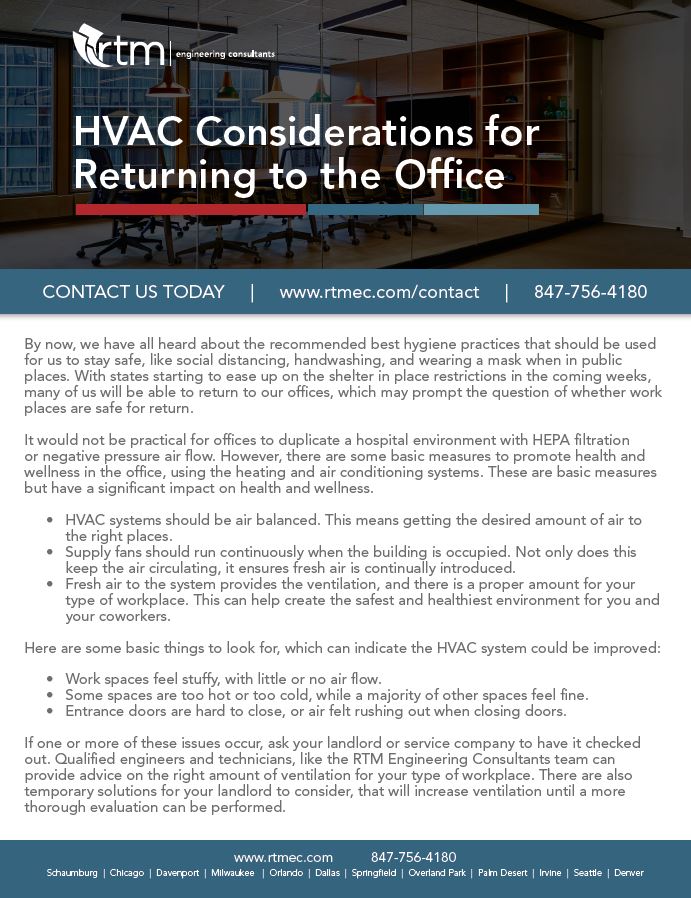By now, we have all heard about the recommended best hygiene practices that should be used for us to stay safe, like social distancing, handwashing, and wearing a mask when in public places. With states starting to ease up on the shelter in place restrictions in the coming weeks, many of us will be able to return to our offices, which may prompt the question of whether work places are safe for return.
It would not be practical for offices to duplicate a hospital environment with HEPA filtration or negative pressure air flow. However, there are some basic measures to promote health and wellness in the office, using the heating and air conditioning systems. These are basic measures but have a significant impact on health and wellness.
-
- HVAC systems should be air balanced. This means getting the desired amount of air to the right places.
- Supply fans should run continuously when the building is occupied. Not only does this keep the air circulating, it ensures fresh air is continually introduced.
- Fresh air to the system provides the ventilation, and there is a proper amount for your type of workplace. This can help create the safest and healthiest environment for you and your coworkers.
Here are some basic things to look for, which can indicate the HVAC system could be improved.
-
- Work spaces feel stuffy, with little or no air flow.
- Some spaces are too hot or too cold, while a majority of other spaces feel fine.
- Entrance doors are hard to close, or air felt rushing out when closing
If one or more of these issues occur, ask your landlord or service company to have it checked out. Qualified engineers and technicians, like the RTM Engineering Consultants team can provide advice on the right amount of ventilation for your type of workplace. There are also temporary solutions for your landlord to consider, that will increase ventilation until a more thorough evaluation can be performed.
For building owners and landlords, there are some strategies to consider for increasing the health and wellness of your tenants and their office suites. Keep in mind COVID-19 has a somewhat unpredictable course, and other novelty viruses in the future may behave differently. A good business approach may be to make some basic changes or return the system to its original optimal performance. This will improve conditions now, without pursuit of more expensive retrofits. Some basics to consider include:
-
- Increase the ventilation rate of your HVAC system. Research organizations like ASHRAE have developed industry standards for ventilating different types of spaces, from hair salons to conference rooms.
- Consider addressing system concerns that may have been overlooked. If your HVAC system was never commissioned, consider doing this. This will identify and solve issues to increase fresh air, improve air filtration, and effectively distribute the In addition to wellness factors, this will also help ensure the building is operating as efficiently as possible, which means saving energy and costs.
- Before implementing new accessories like humidifiers, ionizers, and UV lights, evaluate the effectiveness and overall Over-ventilating a building can lead to other issues like decreased cooling capacity in the summer. Identify what will work best and be cost effective for improvement.
For future projects, new building designs will not necessarily require more elaborate or costly measures. Practical and economical features to enhance health and wellness are attainable. Engineered solutions may be as basic as increasing the exhaust rates in restrooms, breakrooms, and other common areas; or providing new buildings with more daylight or better lighting solutions; also performing new building commissioning to ensure lighting, ventilation, filtration, and air distribution are operating correctly and at optimal levels. These are all strategies that can be considered and provided by your trusted design professionals at RTM.
Together we can work to provide a safe and healthy environment for all of us returning to the workplace, and we can use what we’ve learned to design for a better future. If you or a client of yours is facing these challenges, contact us today to find out how we can help find a solution.

